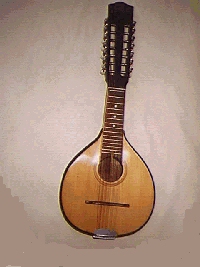Bandurria
Pear-shaped body, with round sound hole, the mainstay of the group and usually carries the main melody, plays melodies and counterparts. Bandurrias may be divided into first, second, and third, each one playing a different part.
| Scale length: 12 in. (distance from the nut to the bridge) Tuning head length:10 1/4 in. Tuning head width: 2 - 2 3/4 in. Fingerboard length: 7 1/8 in. Fingerboard width: at Nut: 2 in.Frets: Total: 14No. of Strings: 14 String gauges: 1st course(3 strings) G unwound steel: .008 in. 2nd course(3 strings) D unwound steel: .010 in. 3rd course(3 strings) A copper-wound steel: .018 in. 4th course(2 strings) E copper-wound steel: .026 in. 5th course(2 strings) B copper-wound steel: .032 in. 6th course(1 string) F# copper-wound steel: .040 in. |  Total length : 25 7/8 in. Body length: 12 in. Body width: 10 in. Sound hole - round: 2 5/8 in. Rim depth: 3 1/8 in. Bridge width: 4 1/2 in. Bridge height: 7/16 in. Bracing: Parallel  |
TUNING
- The bandurria has six(6) sets of strings, tuned in the intervals of fourths.
- First Set (3 strings)
- Tuned to a high G(sol), the second G above the middle C(do) of the piano
- Second Set (3 strings)
- Tuned to D(re), a fourth below the high G
- Third Set (3 strings)
- Tuned to A(la), a fourth below the D
- Fourth Set (2 strings)
- Tuned to E(mi), a fourth below the A
- Fifth Set (2 strings)
- Tuned toB(si), a fourth below the E
- Sixth Set (1 string)
- Tuned to F#(fa), a fourth below the B
- First Set (3 strings)



No comments:
Post a Comment